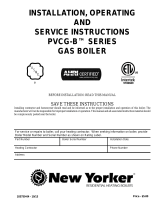
20
TABLE 10. SUGGESTED PIPE SIZE FOR MULTIPLE GAS APPLIANCES (NATURAL GAS)
Nominal Maximum Capacity of Pipe in BTU/hr and kW for Gas Pressures of 14 in. W.C. (0.5 psi) or Less and
Iron Pipe a Pressure Drop of 0.5 in. W.C. (based on 0.60 Specic Gravity Gas w/Heating Value of 1,000 BTU’s/Ft3)
Size Length of Pipe in Feet (Meters)
(Inches) 10 (3.05) 20 (6.1) 30 (9.14) 40 (12.19) 50 (15.24) 60 (18.29) 70 (21.34) 80 (24.38) 90 (27.43) 100 (30.48) 125 (38.1) 150 175 200
1 1/2 BTU/hr 2,100,000 1,460,000 1,180,000 990,000 900,000 810,000 750,000 690,000 650,000 620,000 550,000 500,000 460,000 —
kW 615 428 346 290 264 237 220 202 190 182 161 146 135 —
2 BTU/hr 3,950,000 2,750,000 2,200,000 1,900,000 1,680,000 1,520,000 1,400,000 1,300,000 1,220,000 1,150,000 1,020,000 950,000 850,000 800,000
kW 1,157 805 644 556 492 445 410 381 357 337 299 278 249 234
2 1/2 BTU/hr 6,300,000 4,350,000 3,520,000 3,000,000 2,650,000 2,400,000 2,250,000 2,050,000 1,950,000 1,850,000 1,650,000 1,500,000 1,370,000 1,280,000
kW 1,845 1,274 1,031 879 776 703 659 600 571 542 483 439 401 375
3 BTU/hr 11,000,000 7,700,000 6,250,000 5,300,000 4,750,000 4,300,000 3,900,000 3,700,000 3,450,000 3,250,000 2,950,000 2,650,000 2,450,000 2,280,000
kW 3,222 2,255 1,830 1,552 1,391 1,259 1,142 1,084 1,010 952 864 776 718 668
4 BTU/hr 23,000,000 15,800,000 12,800,000 10,900,000 9,700,000 8,800,000 8,100,000 7,500,000 7,200,000 6,700,000 6,000,000 5,500,000 5,000,000 4,600,000
kW 6,736 4,627 3,749 3,192 2,841 2,577 2,372 2,197 2,109 1,962 1,757 1,611 1,464 1,347
TABLE 11. SUGGESTED PIPE SIZE FOR MULTIPLE GAS APPLIANCES (PROPANE GAS)
Nominal Maximum Capacity of Pipe in BTU/hr and kW for Gas Pressures of 14 in. W.C. (0.5 psi) or Less and
Iron Pipe a Pressure Drop of 0.5 in. W.C. (based on 0.60 Specic Gravity Gas w/Heating Value of 1,000 BTU’s/Ft3)
Size Length of Pipe in Feet (Meters)
(Inches) 10 (3.05) 20 (6.1) 30 (9.14) 40 (12.19) 50 (15.24) 60 (18.29) 70 (21.34) 80 (24.38) 90 (27.43) 100 (30.48) 125 (38.1) 150 175 200
1 1/2 BTU/hr 3,276,000 2,277,600 1,840,800 1,544,400 1,404,000 1,263,600 1,170,000 1,076,400 1,014,000 967,200 858,000 780,000 717,600 670,800
kW 959 667 539 452 411 370 343 315 297 283 251 228 210 196
2 BTU/hr 6,162,000 4,290,000 3,432,000 2,964,000 2,620,800 2,371,200 2,184,000 2,028,000 1,903,200 1,794,000 1,591,200 1,482,000 1,326,000 1,248,000
kW 1,805 1,256 1,005 868 768 694 640 594 557 525 466 434 388 366
2 1/2 BTU/hr 9,828,000 6,786,000 5,491,200 4,680,000 4,134,000 3,744,000 3,510,000 3,198,000 3,042,000 2,886,000 2,574,000 2,340,000 2,137,200 1,999,800
kW 2,878 1,987 1,608 1,371 1,211 1,097 1,028 937 891 845 754 685 626 585
3 BTU/hr 17,160,000 12,012,000 9,750,000 8,268,000 7,410,000 6,708,000 6,084,000 5,772,000 5,382,000 5,070,000 4,602,000 4,134,000 3,822,000 3,556,800
kW 5,026 3,518 2,856 2,421 2,170 1,965 1,782 1,690 1,576 1,485 1,348 1,211 1,119 1,042
4 BTU/hr 35,880,000 24,648,000 19,968,000 17,004,000 15,132,000 13,728,000 12,636,000 11,700,000 11,232,000 10,452,000 9,360,000 8,580,000 7,800,000 7,176,000
kW 10,508 7,219 5,848 4,980 4,432 4,021 3,701 3,427 3,290 3,061 2,741 2,513 2,284 2,102




















